These and other images can be seen on Ryan’s Flickr site

‘Morning’, ‘clear’, ‘15.0’, ”, ‘10.0’, ‘W’, ‘1\\” swell’
‘Boat’, ’30K2923′, ‘Welcome to the Race Rocks Zoo.\r\nThis boat ambled in safely enough, then proceeded to throw food to the sea lions! I have a very clear photo of one man throwing what appears to be baitfish into the air and the other man watching it fly. He proceeded to throw more food until I waved him off.’,Ryan 13:35:49′
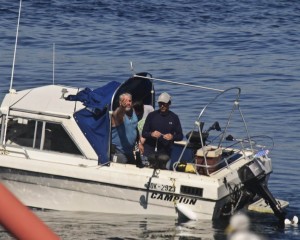
From boat# 30K2923 an individual throws a baitfish to the sea lions from a few metres off the shore. Needless to say this was a first! Noon, September 20, 2009.
In October, 2009, Lester Pearson College had an opportunity to participate in an offshore wind assessment test by AXYS Technologies Inc. in the Strait of Juan de Fuca .
See video of test in Juan de Fuca off Race Rocks
Sidney firm deploys world’s first wind buoy :
Times Colonist,October 28, 2009
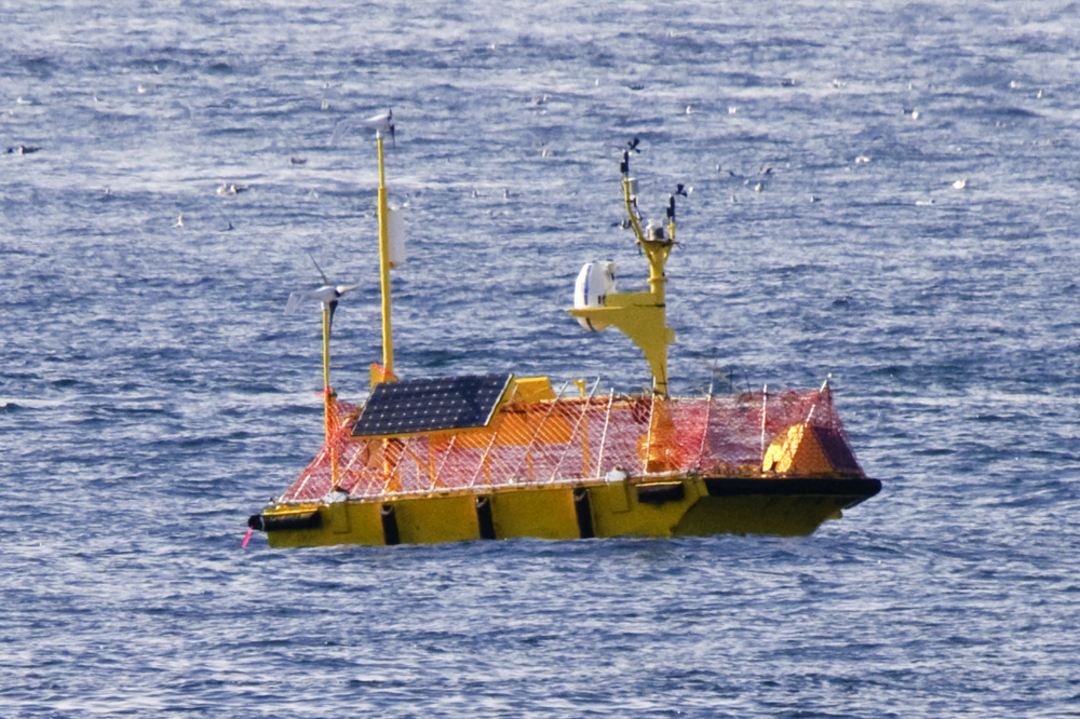
The Wind Sentinnel deployed at Race Rocks on October 18, 2009 -Estimated duration is Oct. 16 – Nov. 16 (logistics/weather dependant) -Buoy Deployment Location – Lat: 48° 17.606’N Long: 123° 32.370’W -Communications – Buoy: Cellular phone -Communications – land station: Race Rocks LAN wired Ethernet connection
Great Race Rocks was used to host the land station for an offshore buoy which is designed to record wind speed and direction data profiles up to 200 meters height. It is anchored outside of the Race Rocks Ecological Reserve in the Strait of Juan de Fuca. Data from the buoy is relayed automatically every 10 minutes by cell phone to the instrument trailer on land and is transmitted to the internet through our LAN on Race Rocks
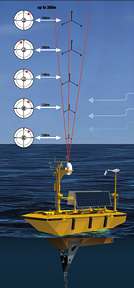 Link to this brochure pdf with more specifications. AXYSWindSentinel
Link to this brochure pdf with more specifications. AXYSWindSentinel
We will be able to benefit by adding the information collected to the knowledge base for the reserve. It will also be useful for planning for future sustainable energy applications.Our current wind measurements done by the Davis weather instrument we have installed on the ground level, often show at least a 10 km/h difference in wind velocity when compared with the Environment Canada data from the top of the tower at 36 metres. A set of data with projections to 200 metres will provide an excellent profile for comparisons.
See this sample file on Analyzing the data as an exercise.
Username: windtrial
Password: axyswind
The left hand window shows the station, which if you click on will expand out to show the messages (metocean and Waves) and if you click the + beside these you will get the individual data parameters which you can plot into a graph by selecting the checkbox of the parameter you want to graph and then clicking the Graph icon at the top of that window.
You can also see a table of the data by simply clicking on the message (click on the 1 MetOcean name and a table will appear on the RHS window with all the data)
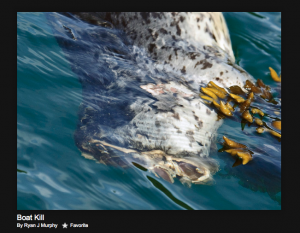 This fall there seems to be an unusual amount of injuries showing up on the marine mammals: Ryan recorded some of them with images on his Flickr site:
This fall there seems to be an unusual amount of injuries showing up on the marine mammals: Ryan recorded some of them with images on his Flickr site:
See this link to the log pages with injured marine mammals.
This dead harbour seal pup was the first of two found in a single week in the waters near Race Rocks. A boat traveling at great speed decapitated this animal and left another slice on the neck in the tell-tale pattern of propeller wounds. Remember Buster?:
He has not been seen in weeks.
2008-09-16′, 6, ‘Garry and Arno out with the racerocks.com Tuesday afternoon activity group to review some of the program plans for the island. We did a video of Mike explaining the operation of the Lister engine on the Winch, and the salt water pumping system. We will make videos to illustrate these back in class later. ‘Garry’

This Rhinocerous Auklet was photographed by Ryan Murphy in Race Passage, late September, 2009
Rhinocerous auklet are frequent fall and winter visitors in the waters around Race Rocks. They forage for feed by diving in groups. The pictures above are of the same group, shown in different positions . Click for enlarged version
Domain Eukarya
Kingdom Animalia
Phylum Chordata
Sub-Phylum Vertebrata
Class Aves
Order Charadriformes
Family Alcidae
Genus Cerorhinca
Species monocerata
Common Name: Rhinocerous Auklet
Other Members of the Class Aves at Race Rocks.
and Image File |
| April 2009 Raisa Mirza |
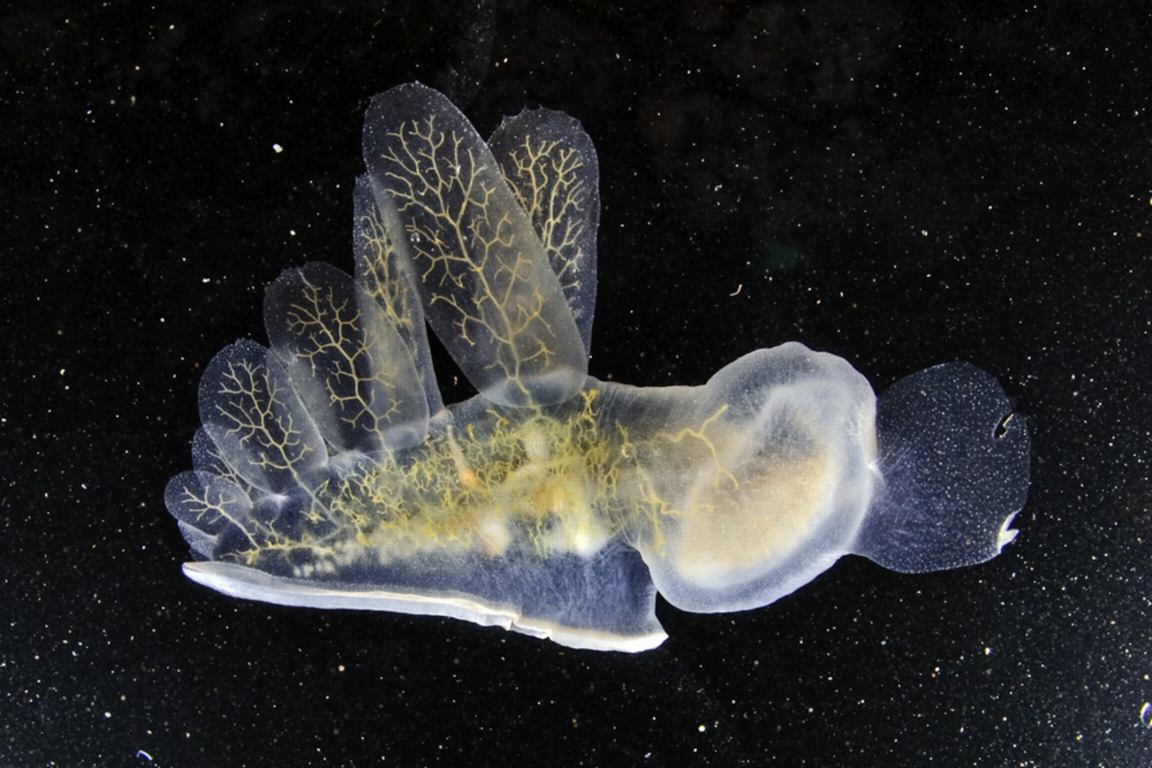 This is a hooded nudibranch (Melibe leonina)… a predatory sea slug that ‘swims’ more often than it crawls. The front end (on the right) has rounded sensory organs called rhinophores that look a bit like elephant ears. In the other picture you can see the head has a big mouth and that can expand to capture all sorts of little critters. The branching structures are ramifications of the digestive system (hepatic diverticula).
This is a hooded nudibranch (Melibe leonina)… a predatory sea slug that ‘swims’ more often than it crawls. The front end (on the right) has rounded sensory organs called rhinophores that look a bit like elephant ears. In the other picture you can see the head has a big mouth and that can expand to capture all sorts of little critters. The branching structures are ramifications of the digestive system (hepatic diverticula).
View other underwater images at Ryan’s Flickr site.
Domain : Eukarya
Kingdom: Animalia
Phylum: Mollusca
Class: Gastropoda
Subclass: Opisthobranchia
Order: Nudibranchia
Superfamily: Tritoniodea
Family: Tethydidae
Genus: Melibe
Species: leonina Gould, 1852
Common Name: Hooded Nudibranch
 The Race Rocks taxonomy is a collaborative venture originally started with the Biology and Environmental Systems students of Lester Pearson College UWC. It now also has contributions added by Faculty, Staff, Volunteers and Observers on the remote control webcams. Ryan Murphy The Race Rocks taxonomy is a collaborative venture originally started with the Biology and Environmental Systems students of Lester Pearson College UWC. It now also has contributions added by Faculty, Staff, Volunteers and Observers on the remote control webcams. Ryan Murphy |
Photos by Ecoguardian Ryan Murphy
Phylum: Phaeophyta
Class: Phaeophyceae
Order: Laminariales
Family: Alariaceae
Alaria nana (Schrader)
Description: The plant is olive brown to yellowish-brown in colour with a conspicuous blade (eroded at maturity), stipe, and holdfast. The holdfast is made up of short, firm root-like structures and is 3-7 cm. long, 5-8 mm. in diameter, merging into a slightly compressed rachis 2-4 cm. long. The rachis in turn merges into the blade, which is linear, tapering gradually to the apex and abruptly to the rachis; the blade is 40-60 cm. long and 3-8 cm. wide with a conspicuous, solid percurrent midrib 4-6 mm. wide.
Habitat: On rocks in the middle and upper intertidal zones in exposed areas.
Pacific Coast Distribution: Alaska to California.
Robert Scagel, 1972
See all Phaeophytes in the Race Rocks Taxonomy
 The Race Rocks taxonomy is a collaborative venture originally started with the Biology and Environmental Systems students of Lester Pearson College UWC. It now also has contributions added by Faculty, Staff, Volunteers and Observers on the remote control webcams. Ryan Murphy PC yr 26 The Race Rocks taxonomy is a collaborative venture originally started with the Biology and Environmental Systems students of Lester Pearson College UWC. It now also has contributions added by Faculty, Staff, Volunteers and Observers on the remote control webcams. Ryan Murphy PC yr 26 |
Race Rocks Public Advisory Board Draft Terms of Reference
Note : May 2010–DFO has replaced this draft version by the one that was linked here.
1. Introduction:
Section 35 (1) of the Oceans Act provides the authority for the nomination or recommendation and establishment of Marine Protected Areas (MPAs). An MPA may only be established for one or more of the following reasons. The conservation and protection of:
Commercial and non-commercial fisheries, including marine mammals and their habitats;
Endangered or threatened species and their habitats;
Unique habitats;
Marine areas of high biodiversity or biological productivity; or
Any other marine resource of habitat as is necessary to fulfill the mandate of the Minister of Fisheries and Oceans.
The Race Rocks marine area has been recommended as a Marine Protected Area of Interest for a number of reasons. As a transition zone between the Pacific Ocean and coastal waters, the area is renowned for its exceptional diversity of marine life. It is an area of high biodiversity and biological productivity. It is important habitat for marine mammals and the area provides habitat for threatened species.
From a First Nation’s perspective the area has cultural significance with respect to traditional use and management of the area’s resources. There is recognition that, should a Marine Protected Area be established, the Government of Canada as represented by DFO will work cooperatively with the First Nations in the care and management of the MPA towards a common vision for the MPA.
The Race Rocks group of islets and submerged land was designated as an Ecological Reserve in 1980 under the province of British Columbia’s authority and a cooperative management relationship has been developed with Lester B. Pearson College of the Pacific. DFO and BC Parks, in collaboration with First Nations, stakeholders and the public, are aiming to develop further management strategies to support conservation objectives for the area. To aid in this purpose the Race Rocks Public Advisory Board (RRPAB) has been convened with representation from a number of stakeholder groups and levels of government.
2. Purpose:
The Race Rocks Public Advisory Board has been established to enable a Marine Protected Area designation under the Oceans Act at Race Rocks. The terms of reference have been developed to clarify the objectives, process, role and conduct of the Advisory Board.
3. Objectives:
The Race Rocks Public Advisory Board will:
provide a forum for consultation and deliberation among its participants as a source of consensus-based advice to BC Parks and DFO. Such consensus advice shall fairly represent the collective and individual views of the RRPAB members and the constituencies they represent.
delineate geographical boundaries of the proposed MPA to achieve objectives
provide advice to DFO on the consultation process
collate, analyze and summarize feedback from consultations
provide advice on the issues and activities that may have an impact on the ecological components of the MPA
ensure community involvement in the establishment of Race Rocks MPA
4. Participation, Roles and Responsibilities:
Participants:
The Race Rocks area is of interest to a wide range of constituents representing a broad spectrum of activities. The RRPAB represents a reasonably comprehensive cross-section of interest groups and activities. The RRPAB shall be comprised of, but not limited to, representatives from the following groups:
Fisheries and Oceans Canada
BC Parks
Parks Canada Agency
First Nations
Department of National Defence
Lester B. Pearson College
Sports Fishery Advisory Board
Whale Watchers Operators Association
Scientific Community
Dive Community
Georgia Strait Alliance
Friends of Ecological Reserves
Canadian Parks and Wilderness Society
Local Marina Operators
If a member/participant is unable to attend a scheduled Board meeting, they may invite an alternate from their constituency. Participants are encouraged to invite other members of their groups to attend RRPAB meetings, with prior notification of the Chair and subject to space limitations.
Roles and Responsibility of Advisory Board Participants:
The RRPAB shall act solely as an advisory body to BC Parks and Fisheries and Oceans Canada. Nothing in these terms of reference constitutes authority to perform operational or management functions, or to represent or make decisions on behalf of BC Parks or DFO.
Participants on the Race Rocks Public Advisory Board are encouraged to:
Openly provide information on their activities and the activities of the constituents they represent within and surrounding Race Rocks
actively participate in discussions
share airtime with others
offer respect for different viewpoints and attention when others are speaking
ask questions for clarification and mutual understanding
verify assumptions
deal with differences as issues to be discussed, not positions to be defended
refrain from distracting others through side conversations, cell phones off
make a best faith effort to work toward an agreement at the table
wherever possible ensure that agreements developed are acceptable to the organizations, agencies or constituents that you represent
maintain dialogue with your constituency regarding the activities and discussions of the Race Rocks Public Advisory Board
refer media contacts regarding the activities of the Board to the Chair/facilitator. Board members can speak on behalf of the Board not on the behalf of individual members.
5. Process:
Recommendations by the RRPAB will be made through a consensus-based process. The intent of this process is to provide the opportunity for all parties to participate in a manner which responds to their interests. If issues arise, whenever possible, recommendations supported by consensus as opposed to being unilaterally imposed.
Consensus shall mean the “general agreement of all participants on a package of recommendations” and shall embody the following concepts:
Consensus does not mean total concurrence on every aspect of a decision, but all participants must be willing to accept the overall decision package.
If a participant withholds agreement on an issue(s), that participant is responsible for explaining how their interests are adversely affected or how the proposed agreement fails to meet its interests. The participant withholding agreement must propose alternatives and other participants must consider how all interests may be met.
Once consensus is reached on the overall package of advice, it is assumed to be binding (Cormick et al. 1996).
If consensus is not achieved through this process, each participant will exercise their rights, responsibilities, and mandates as they see fit — unfettered as to statutory decision-making responsibilities and without prejudice to their rights and obligations by reason of having participated in the process.
6. Meetings:
Meetings will be held periodically to assess and evaluate RRPAB’s activities and input. The chair / facilitator will be responsible to call meetings as interest or issues develop. RRPAB members are also able to call a meeting if a topic has to be addressed.
7. Deliverables:
The RRPAB will deliver recommendations to BCParks and DFO related to the designation of the MPA, with respect to the conservation objectives, the management objectives, monitoring, enforcement, public education and awareness and other MPA-related activities.
8. Timeline:
It is expected that the Race Rocks Advisory Board, as outlined by these terms of reference, will complete the tasks described by 31 March, 2010.
9. Responsibilities of Fisheries and Oceans Canada and B.C. Parks:
Fisheries and Oceans Canada and B.C. Parks support the sharing of information and dialogue from the consultative process. Representatives from the respective departments on the Race Rocks Public Advisory Board will endeavour to fairly represent the management recommendations developed by the Race Rocks Public Advisory Board. B.C. Parks and Fisheries and Oceans Canada will review the recommendations of the Advisory Board and consider those recommendations when developing criteria for the designation and management of Race Rocks Marine Protected Area.
Ryan Murphy took these photos of some of the injured marine mammals showing up at Race Rocks this year . See more on his Fickr Site .